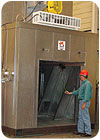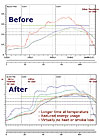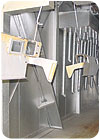Hot Technologies for Efficient Curing
Today’s oven requirements include in-line continuous (non-batch) processing, fast heat-up and consistent temperature maintenance, maximized time at temperature to effectively lengthen the usable oven, and contained oven heat and smoke to minimize energy usage and provide a better employee work environment. Innovations such as advanced heat seals, sophisticated air management systems and continuous pyrolytic burn-off ovens can address these diverse goals and help finishing professionals improve quality and profitability.

What do finishing professionals expect of their oven systems? The short answer is everything. Curing ovens must optimize finish quality, have a low total cost of ownership, increase production efficiency, and cater to ergonomics and human factors.
These expectations are driving today’s oven requirements, which include in-line continuous (non-batch) processing, fast heat-up and consistent temperature maintenance, maximized time at temperature to effectively lengthen the usable oven, and contained oven heat and smoke to minimize energy usage and provide a better employee work environment.
Innovations such as advanced heat seals, sophisticated air management systems and continuous pyrolytic burn-off ovens can address these diverse goals and help finishing professionals improve quality and profitability.

To further improve oven efficiency, the heat seal system can be used in conjunction with a sophisticated air management system that uses thermal and pressure sensors to monitor the oven environment at critical locations and control the airflow. When used together, these technologies regulate the oven to compensate for changing ambient conditions and automatically maintain the desired internal temperature profile.
Other benefits of using advanced heat seals with an air management system include:

To counter this problem, pyrolytic burn-off ovens are used. In these hot chambers, fixtures catch fire, and the coated materials are literally burned off. With this process, however, come serious drawbacks, including melting, warpage, metal fatigue and a shortened fixture life.
The advanced heat seal system can be used in pyrolytic cleaning ovens to create high-humidity/low-oxygen oven atmospheres. Such atmospheres allow thorough, fire-free cleaning of painted fixtures, thereby ensuring the proper conductivity and grounding for powder coatings. Modern pyrolytic ovens use automated controllers to monitor and adjust the cycle time and temperature to better control the cleaning process.
A more recent innovation** uses a continuous (rather than batch) design, along with a patented process that establishes a controlled low-oxygen atmosphere with water-vaporized air to inhibit combustion and increase the air’s BTU capacity. This design enables optimal pyrolysis at lower oven temperatures or reductions in the cleaning cycle at the same temperature. The system also reduces cool zones where inadequate heating temperatures are achieved, and it is well insulated to reduce heat loss.
Temperature spikes, typical in burn-off ovens, are eliminated in the new system, ensuring that the fixtures do not become too hot and melt or warp. The elimination of temperature spikes extends service life and negates the need to water spray the parts to control the fires, thus minimizing ash and cleanup.
Because the system eliminates the batch oven process typical of industry standard pyrolysis ovens, it provides substantial labor and energy savings. Continuous material flow processing provides tremendous production efficiencies compared to batch processing because it avoids the need to heat and cool the oven repetitively. Production rates, capacities and efficiencies are significantly improved.
For more information about curing systems, visit www.abmyr.com.
*The Air Barrier heat seal from A.B. Myr Industries.
**The Pyrolytic Coating Gasification Oven (CGO) from A.B. Myr Industries.

This oven incorporates an Air Barrier heat seal developed by A.B. Myr Industries. The oven is operating at 800°F, but the air at the oven door exterior is at room temperature.
What do finishing professionals expect of their oven systems? The short answer is everything. Curing ovens must optimize finish quality, have a low total cost of ownership, increase production efficiency, and cater to ergonomics and human factors.
These expectations are driving today’s oven requirements, which include in-line continuous (non-batch) processing, fast heat-up and consistent temperature maintenance, maximized time at temperature to effectively lengthen the usable oven, and contained oven heat and smoke to minimize energy usage and provide a better employee work environment.
Innovations such as advanced heat seals, sophisticated air management systems and continuous pyrolytic burn-off ovens can address these diverse goals and help finishing professionals improve quality and profitability.

Figure 1. An oven temperature profile before and after the installation of an Air Barrier heat seal.
Invisible Air Barriers
Effective heat seals are a crucial component of an efficient oven. Some of the most advanced heat seals aren’t really seals at all, but rather a system* that creates an invisible air barrier to keep the heated air in the oven without hindering or restricting the work openings. The system draws hot oven interior air and compresses it in scroll fans. Centrifugal fans are used to force the air into the open work openings. The pressurization difference between the factory and the oven interior keeps the hot oven air from entering the factory. This sealing system can contain up to 90% of the heat that otherwise would escape from the oven.To further improve oven efficiency, the heat seal system can be used in conjunction with a sophisticated air management system that uses thermal and pressure sensors to monitor the oven environment at critical locations and control the airflow. When used together, these technologies regulate the oven to compensate for changing ambient conditions and automatically maintain the desired internal temperature profile.
Other benefits of using advanced heat seals with an air management system include:
- Efficient in-line processing. An effective heat seal system increase the efficiency of in-line, continuous processes by containing the oven heat and smoke that can escape through the work openings at either end of the oven.
- Increased cycle times and production rates. In dry-off ovens, a fast temperature ramp-up and controlled air circulation can effectively extend the length of the usable oven to remove surface moisture on parts from the pretreatment process that otherwise would lead to finish imperfections and solvent popping. In powder coating cure ovens, these technologies create a low-velocity, superheated zone to gel the powder rapidly without the use of high-maintenance infrared heaters before the parts enter the high-velocity, energy-efficient convection zones. The combination of an effective heat seal system and sophisticated air management works much better than the conventional “quiet zone” and uses less energy.
- Longer time at temperature. An effective heat seal system causes the product to heat up faster, thus increasing oven efficiency. It also maximizes the part’s time at temperature, thus enabling greater production rates, shorter oven lengths and reduced oven temperatures (see Figure 1).
- Self-balancing. Using an effective heat seal and air management system allows the oven to “self-balance,” automatically compensating for changing ambient conditions to maintain the desired internal temperature profile.
- Real-time temperature profiling. Some air management systems incorporate real-time temperature profiling, which allows the oven to be adjusted to meet incoming product or production requirements.
- Reduced energy costs. Using advanced heat seal and air management systems can cut energy use by 50 to 70% and provide a quick payback.

Using an effective heat seal with a sophisticated air management system allows the oven to be regulated to compensate for changing ambient conditions so that the desired internal temperature profile is maintained.
Continuous Pyrolysis
In electrostatic paint operations, the parts being painted must be cleaned thoroughly to maintain electrical conductivity. Traditionally, a DC electrical current is sent through the fixture to the metal part being painted. Oppositely charged airborne paint particles are drawn to the metal part and deposited on its surface, as well as on the fixture holding the part. A single layer of paint on a fixture can reduce its conductivity by half. Multiple layers of paint on the fixtures act as an effective electrical insulator, thus preventing the electric current from reaching the part being painted and impacting the quality of the finish. Additionally, the layered paint tends to powder and flake over time, dropping onto the parts being painted. Both factors - reduced and unpredictable electrical conductivity and paint flaking - can significantly reduce the finish quality.To counter this problem, pyrolytic burn-off ovens are used. In these hot chambers, fixtures catch fire, and the coated materials are literally burned off. With this process, however, come serious drawbacks, including melting, warpage, metal fatigue and a shortened fixture life.
The advanced heat seal system can be used in pyrolytic cleaning ovens to create high-humidity/low-oxygen oven atmospheres. Such atmospheres allow thorough, fire-free cleaning of painted fixtures, thereby ensuring the proper conductivity and grounding for powder coatings. Modern pyrolytic ovens use automated controllers to monitor and adjust the cycle time and temperature to better control the cleaning process.
A more recent innovation** uses a continuous (rather than batch) design, along with a patented process that establishes a controlled low-oxygen atmosphere with water-vaporized air to inhibit combustion and increase the air’s BTU capacity. This design enables optimal pyrolysis at lower oven temperatures or reductions in the cleaning cycle at the same temperature. The system also reduces cool zones where inadequate heating temperatures are achieved, and it is well insulated to reduce heat loss.
Temperature spikes, typical in burn-off ovens, are eliminated in the new system, ensuring that the fixtures do not become too hot and melt or warp. The elimination of temperature spikes extends service life and negates the need to water spray the parts to control the fires, thus minimizing ash and cleanup.
Because the system eliminates the batch oven process typical of industry standard pyrolysis ovens, it provides substantial labor and energy savings. Continuous material flow processing provides tremendous production efficiencies compared to batch processing because it avoids the need to heat and cool the oven repetitively. Production rates, capacities and efficiencies are significantly improved.
The Bottom Line
Using advanced technologies to upgrade or replace the existing ovens in a finishing system can reduce energy costs by 50 to 70%, increase product quality and first-pass yield rates, improve production capabilities, and create a safer and more pleasant work environment. Further, investing in such innovations can provide a quick return on investment and yield significant savings year after year.For more information about curing systems, visit www.abmyr.com.
*The Air Barrier heat seal from A.B. Myr Industries.
**The Pyrolytic Coating Gasification Oven (CGO) from A.B. Myr Industries.
Looking for a reprint of this article?
From high-res PDFs to custom plaques, order your copy today!



